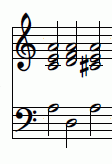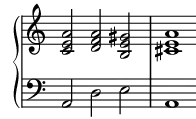Picard third
In music, the Picardian third is the major major - third in the tonic final chord of a musical section that is actually in the minor key . The minor triad was considered a dissonance up to the Renaissance , as Zarlino (1558) explains , and therefore the perfect major chord has prevailed as a lightening in the final chord .
- Explanation: A pure major chord produces difference tones that result in nothing other than the same major chord again, whereas the minor chord produces difference tones that produce something completely different. In the major chord the overtones correspond to a large extent , but not so in the minor chord.
Jean-Jacques Rousseau attributes the term “Picardian third” ( Tierce de Picardie ) in his Dictionnaire de Musique (1768) to the fact that the practice described above (major ending in the minor context) has been cultivated for the longest in church music accordingly, especially in the French province of Picardy with its numerous cathedrals and churches.
In contrast, Robert A. Hall puts forward the hypothesis that the geographical indication “de Picardie” is a reinterpretation of the old French adjective picart, picarde (German: “sharp”, “pointed” ); with tierce picarde a “sharpened” major third was described at the end of a section held in minor .
This tradition lasted as a convention into the baroque era. With Johann Sebastian Bach, for example, many chorales, organ toccatas etc. that are in a minor key end with a major chord, but sometimes even (for example in the toccata and fugue in D minor BWV 565 ) with a minor chord. After the Baroque era, major closings in minor compositions can only be regarded as a means of expression and have therefore become less common. In Mozart's time, the minor closure in the minor keys was already common.
Simultaneously with the disappearance of the Picardy third, the mean-tone tunings were replaced by well-tempered tunings . It is a controversial thesis that the practice of the major final chord was abandoned due to the introduction of the well-tempered tunings.
Audio sample :

|
purely mid-tone equal |
Comparison of the interval sizes (in cents ):
| interval | purely | mid-tone | equal |
|---|---|---|---|
| major third {a – cis 'or c'– e'} | 386 | 386 | 400 |
| minor third {a – c 'or cis'-e'} | 316 | 310 | 300 |
| Fifth {a – e '} | 702 | 697 | 700 |
Sources and literature (chronological)
- Jean-Jacques Rousseau: Dictionnaire de Musique . Paris 1768 ( online at rousseauonline.ch , full text search possible).
- Robert A. Hall Jr .: How Picard was the "Picardy Third"? . In: Current Musicology . No. 19, 1975, pp. 78-80 ( online ).
